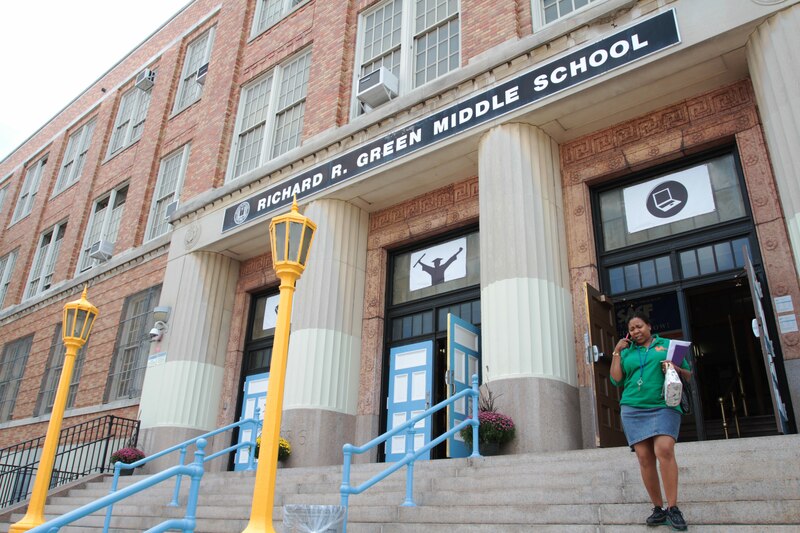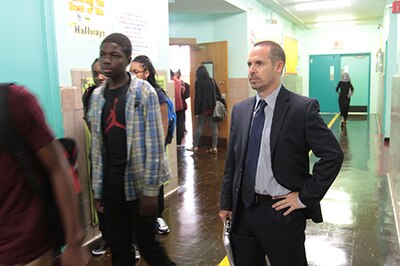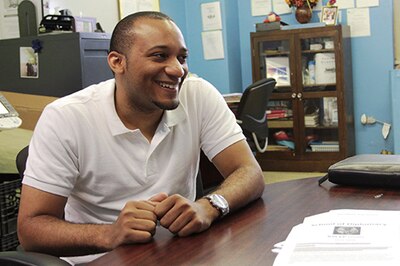
The Richard R. Green campus is a drab, three-story brick building in the northwest Bronx. But this year, its metal fences are adorned with banners for each of the four schools inside and new flowers line the entranceway, where the doors have been painted bright blue and lampposts are now school-bus yellow.
The changes didn’t go unnoticed at the campus, which teachers say has a longstanding negative reputation in its Williamsbridge neighborhood. As students returned to school Wednesday, kids took photos of the new façade and parents danced to music playing near the entrance. A few students from one school even thought they were on the wrong floor of the building because the hallways were unrecognizable.
“The kids themselves have a different perception,” said Shamika Powell, a seventh-grade English teacher who just started her seventh year at the School of Diplomacy, one of the schools in the building. “You feel like you really want to be here.”
All four of the building’s middle schools are struggling to raise their students’ low reading and math proficiency rates, and three are a part of the city’s “Renewal” turnaround program. Schools in that program are expected to show academic improvements over the next two years, and at the start of this high-stakes school year, officials said they hoped the building’s new, welcoming environment would lay the groundwork for more comprehensive changes to come.
“We’ve been doing a lot of work around re-branding and getting good buzz out there for the campus, because they need it,” said Juanita Rodriguez, who is directing the Renewal program for District 11, which encompasses the northwest Bronx. “There’s a bad rep and stigma for this school that’s just not right.”
Like most of the city’s struggling schools, the three inside the Richard R. Green campus — School of Diplomacy, Young Scholars Academy, and Globe School for Environmental Research — face formidable challenges. Nearly all of the students come from low-income families, and about a quarter have special needs. In 2015, proficiency rates in English ranged from 7 to 12 percent, while math proficiency hovered around 6 percent. Enrollment has been declining over the last two school years, and attendance remains under 90 percent.
The de Blasio administration is betting that it can direct resources to those schools to help them improve. The city’s plans, announced last November, include adding social services and health facilities to address students’ needs as well as adding extra learning time for students and training for teachers. The first 10 months of the program were a planning period for most schools, with this fall serving as the initiative’s true kickoff.
On Wednesday, teachers and students at the Richard R. Green campus saw the plans inch closer to reality.

The three Renewal schools chose Phipps Neighborhoods, a nonprofit, as their city-funded partner organization. (The decision to bring the same community-based organization into the building is one of several examples of collaboration among the school leaders.)
On Wednesday, Phipps was in place to help provide after-school programming, which will range from academic help to sports, adult learning workshops, and training for teachers focused on student behavior, program director Joel Sanchez said.
A satellite mental-health clinic is expected to open in the building by early October, with help from Phipps. The clinic will be available to the students and family members of all four schools on the campus, including the campus’s non-Renewal school, the Forward School of Creative Writing.
Astor Services for Children and Families, another nonprofit social services agency, will staff the clinic three days a week with a supervising psychologist and four licensed social workers, Sanchez said. Once it opens, every student on campus will be assessed for mental health needs, and services will be available to eligible students at least once per week. If more advanced services or medication is needed, students and family members will be referred to an off-site clinic a few blocks from the school.
The schools will also soon be staffed with AmeriCorps service members to help with family outreach and to mentor chronically absent students.
“It’s tangible,” said Sean Licata, who is starting his fourth year as principal of the School of Diplomacy, one of the Renewal schools. “It’s really taken foot and it’s starting to run.”
Still, the schools were still dealing with fresh challenges as the year began. Two schools — Young Scholars Academy and Globe School — were just labeled “persistently dangerous” by the state. School leaders say those labels has more to do with the way certain incidents were categorized than the school’s level of safety, but some parents still arrived on day one requesting to have their child transferred.

And the stubborn challenge of boosting students’ academic performance, which cannot be shifted simply with new social services or facility upgrades, hangs over the schools. By February, they are expected to improve student attendance and reduce suspension rates, plus demonstrate a higher quality and rigor of student work, with increased independent reading and writing time.
At the School of Diplomacy, for example, Licata extended the end of the school day from 3 p.m. to 4 p.m. Students will spend the extra hour rotating among academic subjects every six weeks, from literature circles to math. Advanced students will be given other opportunities like participating in science labs.
Jeanette Vargas, the principal of Young Scholars Academy, said her school is focused on improving students’ reading and writing skills. Students started using a new digital literacy program last spring, she said, and teachers are having students read aloud more frequently and are holding more class discussions.
“The thing is to really find what’s going to work,” she said, “and we have put things in place and we’re moving them forward.”
